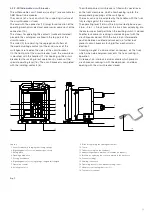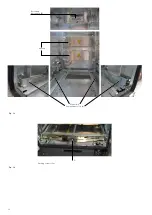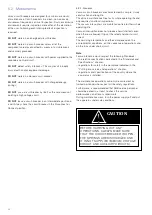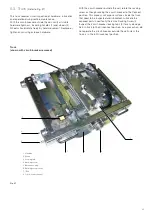
20
4.6.2. Safety indications
Vmax circuit-breakers guarantee a minimum IP2X degree of
protection when installed in the following conditions:
– fixed circuit-breaker, installed behind a protective metallic net
– withdrawable circuit-breaker, installed in switchgear.
under these conditions the operator is totally guaranteed
against accidental contact with moving parts.
Should mechanical operations be carried out on the circuit-
breaker outside the switchgear, be very careful of the moving
parts.
If the operations are prevented, do not force the mechanical
interlocks and check that the operating sequence is correct.
Racking the circuit-breaker in and out of the switchgear must
be done gradually to avoid shocks which may deform the
mechanical interlocks.
4.6.3. Preliminary operations
– Clean the insulating parts with clean dry cloths.
– Check that the top and bottom terminals are clean and
free of any deformation caused by shocks received during
transport or storage.
insertion:
(Refer to Fig. 7 and Fig. 13)
(from withdrawn position)
1. Align the circuit-breaker and ramp, dolly or lift truck with
the compartment.
2. Pull the handles (17) to center (this withdraws Cell Interlock
Tabs (11) allowing the circuit-breaker to be inserted).
3. Push the circuit-breaker into the compartment with the
handles.
4. Align the circuit-breaker interlock tabs with the
compartment slots (A).
5. Push the handles out to fully engage the cell interlock tabs
into the compartment slots.
6. Visually check that cell interlock tabs are engaged in
the compartment slots (if cell interlock tabs are not fully
extended, racking is prevented).
7. The circuit-breaker is now in the Disconnect position.
Removal:
to withdrawn Position
(Refer to Fig. 7)
1. Visually verify that the truck (10) is against the truck locator
channel (18).
2. Pull the handles (17) to the centre.
3. Pull the circuit-breaker from the compartment with the
handles onto the required transportation device.
4. The circuit-breaker is now in the withdrawn position.
4.6.4. Racking vmax/w: (figure 7)
Vmax/w circuit-breakers are designed with two positive
racking positions: Disconnect, Connect. In the Disconnect
position the shutters are closed. Manual opening is allowed.
Electrical operation of the circuit-breaker is allowed with
control power supplied through the secondary contacts with
the shutters closed. As the circuit-breaker approaches the
Connect position, an increase in racking force is required to
lift the shutters and to engage the primary contacts. In the
Connect position, the primary disconnects are fully engaged
and the shutters are open. Electrical operation of the circuit-
breaker through the secondary contacts remains enabled.
Close door racking is mandatory between all positions
1.
Engage the racking handle (item 1 Figure 11) with the
racking screw collar (item c Figure 14).
a. CLOCkwISE (cw) rotation inserts the circuit-breaker
towards the primary contacts.
b. COuNTER-CLOCkwISE (ccw) rotation withdraws the
circuit-breaker away from the primary contacts.
Circuit-breaker rack-ing-in/-out must be carried out gradually
to avoid shocks which may deform the mechanical interlocks
and the end-of-runs.The torque normally required to carry out
rack-ing-in and racking-out is <25 Nm.This value must not be
exceeded. If operations are prevented or difficult, do not force
them and check that the operating sequence is correct.
4.6.5. disconnect through connect
1.
Perform a visual inspection of the circuit-breaker:
a. Verify Close/Open Indicator shows OPEN.
IF NOT, OPEN THE CIRCuIT-bREAkER (CONNECT
OPERATION IS PREVENTED wHILE CIRCuIT-bREAkER
IS CLOSED)
2.
Racking-in operation:
a. Verify switchgear door is CLOSED
b. begin racking by rotating the racking handle to the
CLOCkwISE direction.
c. Twenty (20) revolutions (200mm) will move the circuit-
breaker between the Test and Connect positions.
• The Connect position is indicated by a positive lock,
preventing further racking shaft rotation.
• Electric and mechanical closing operation of the circuit-
breaker are prevented between Test and Connect
positions.
















































